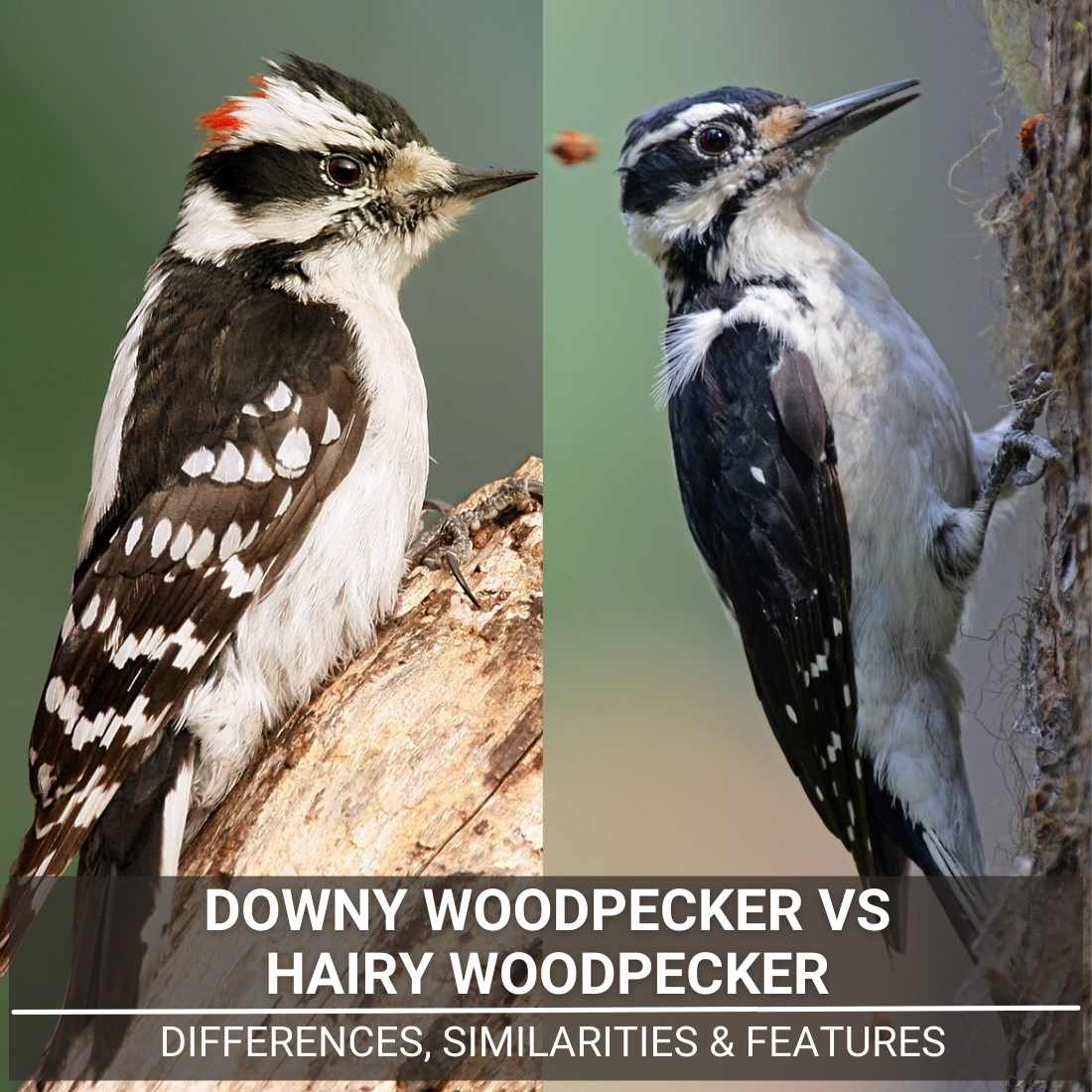In North America, the Downy and Hairy woodpeckers may be found in abundance. They are two of the most prevalent woodpecker species that may be found in the United States. They can be a challenge to inexperienced or unskilled observers when it comes to identification.
View the overview below to see how the Downy Woodpecker and the Hairy Woodpecker differ from one another.
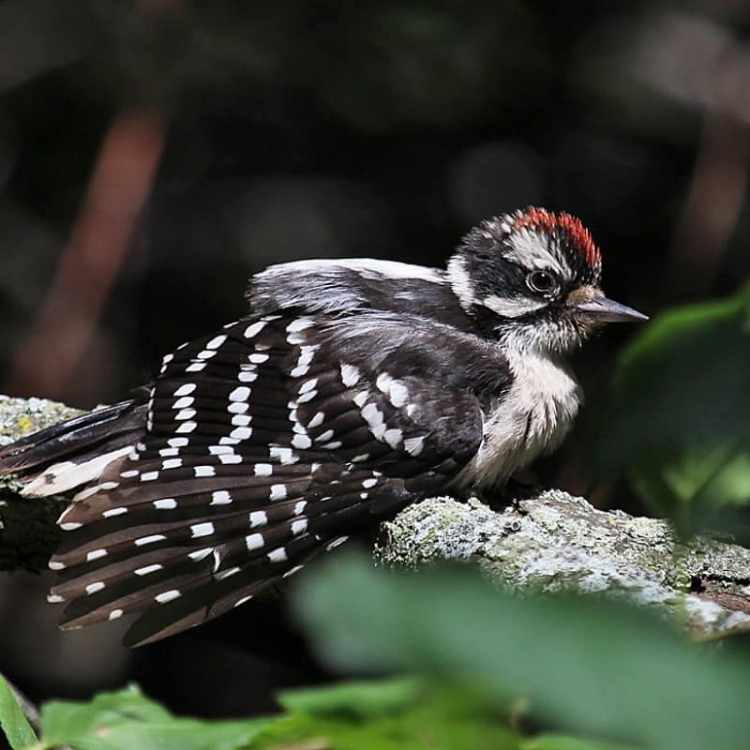
Table of Contents
- 1 Overview
- 2 Differences between Downy Woodpecker vs Hairy Woodpecker
- 3 Similarities between Downy Woodpecker vs Hairy Woodpecker
- 4 Interesting facts about Downy Woodpeckers
- 5 Interesting facts about Hairy Woodpeckers
- 6 Field Identification Tips
- 7 Final Verdict
- 8 Frequently Asked Questions
- 8.1 What is the easiest way to identify a Downy Woodpecker versus a Hairy Woodpecker?
- 8.2 Why do Downy and Hairy Woodpeckers look so similar to birdwatchers?
- 8.3 How can you distinguish Downy and Hairy Woodpecker tail feathers?
- 8.4 What do Downy Woodpeckers eat compared to Hairy Woodpeckers?
- 8.5 Where do Downy and Hairy Woodpeckers live in North America?
- 8.6 What are the lifespan differences between Downy and Hairy Woodpeckers?
- 8.7 How do Downy and Hairy Woodpecker calls differ?
- 8.8 Do Downy and Hairy Woodpeckers migrate differently?
- 8.9 What physical adaptations help Hairy Woodpeckers peck wood effectively?
- 8.10 How many eggs do Downy and Hairy Woodpeckers typically lay?
Overview
| Downy Woodpecker | Hairy Woodpecker |
|---|---|
| Downy Woodpecker makes the whinnying call which lasts for about 2 sec. | In comparison to the Downy Woodpecker’s call, the Hairy Woodpecker’s sound is petite, sharper, and more powerful. |
| 9.8 to 12.2 inch wingspan | 15 inch wingspan |
| Somewhat rounded wings | Completely rounded wings |
| Downy woodpeckers are indigenous to deciduous forests in North America. | The Hairy Woodpecker may be found from the coast to the highlands in North America and Central America’s mountain forests. |
| A small black-and-white woodpecker | A large black-and-white woodpecker |
| The average size is 6.5 inches | The average size is 9.5 inches |
| The Downy Woodpecker’s whitish outer tail plumes are commonly speckled with black. These black bars are best seen from below. They may appear white from above. | In much of the Eastern U.S., Hairy Woodpecker has totally white outer tail feathers. |
| Do not make flock usually lives alone | Some time make a flock of 2-3 birds but prefer to live alone |
| They like suet feeders and enjoy millet, almonds, and chunky nuts. | Eat mostly bugs. Feeds on wood-boring beetle larvae, ladybugs, wasps, moths, and other insects. Also, eats berries, seeds, and nuts. |
| The average lifespan is four years (wild) | The average lifespan is 12 years (wild) |
| Many are permanent residents; however northernmost populations may migrate south in winter. | Do not migrate |
| Have 3-8 eggs in on the clutch | Have 3-6 eggs in on the clutch |
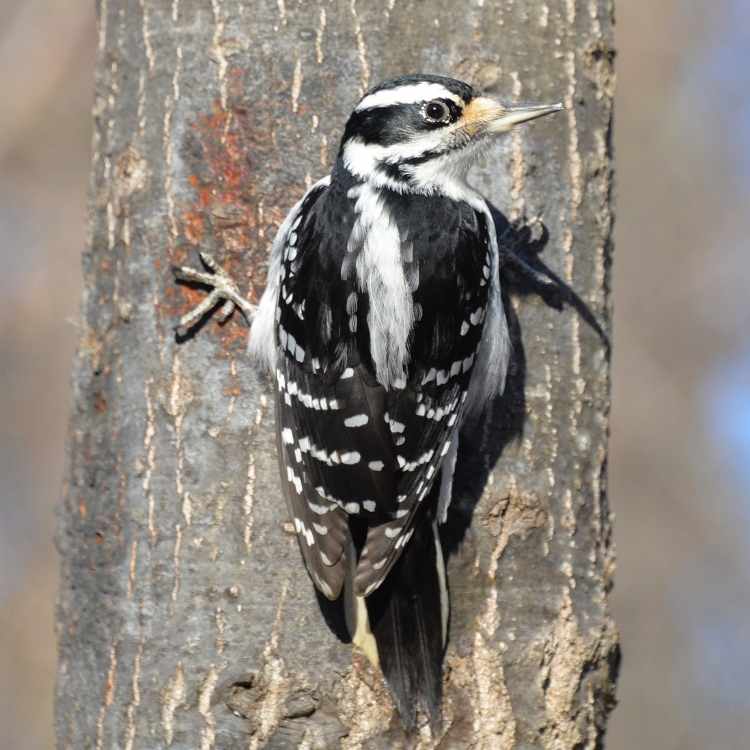
Differences between Downy Woodpecker vs Hairy Woodpecker
Appearance
Downy woodpeckers have several black lines or spots on their whitish tail feathers, but the outer tail feathers of hairy woodpeckers are normally plain and unmarked. Downy woodpeckers are more common than hairy woodpeckers.
Examining the structure of their bills is a more reliable technique of determining the size disparities between them. The downy has a short, stubby beak that is just slightly longer than the space between the front of its head and the corner of its eye. This bird’s beak is far longer and stronger than that of other woodpeckers, and it is almost as long as the bird’s head.
Habitat
Aside from sharing some of the same natural environments, downy woodpeckers are much more likely to be spotted in suburban areas, and small parks than hairy woodpeckers are. Hairy woodpeckers prefer densely wooded regions with huge trees as their preferred habitat.
Diet
Downy Woodpeckers are suet eaters, although they also eat millet, almonds, and chunky nuts in addition to suet and nuts.
The Hairy Woodpecker, on the other hand, mostly consumes insects. It preys on various insects, including wood-boring beetle larvae, ladybugs, wasps, moths, and other species. He also consumes berries, seeds, and nuts.
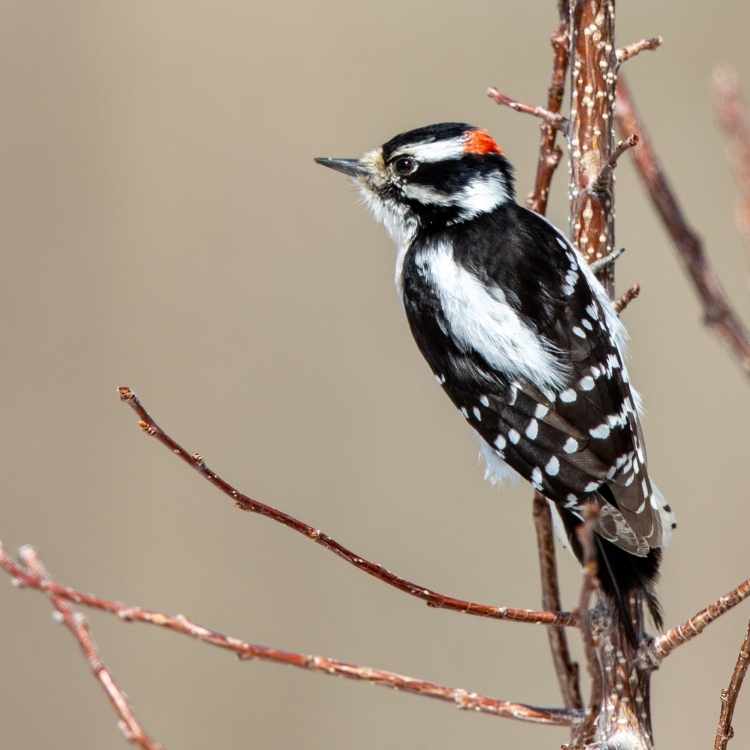
Size
In comparison to its downy relative, the hairy woodpecker is significantly bigger, measuring around nine inches from the tip of its beak to the end of its tail. (By comparison, the downy woodpecker measures around six and a half inches in length.) Their size difference is only noticeable when they are side by side, which is rare.
Behavior
Most people have heard the downy woodpecker’s calls, which are short and pleasant picks punctuated by a high-pitched, declining whinny. Unlike the hairy woodpecker, which has a softer call, the hairy woodpecker makes a sharp, captivating peek! Sound similar to that of a squeaky chew toy. Also, you like the downy woodpecker; the hairy woodpecker has a harsh rattle that stays at a single pitch.
Sometimes, particularly in the case of juvenile hairy woodpeckers, the head patch appears yellow rather than red. Young hairy woodpeckers may have additional black markings on their sides or white stripes down their backs.
Similarities between Downy Woodpecker vs Hairy Woodpecker
Both Downy Woodpecker and Hairy woodpeckers are common throughout Northern America. Both birds frequently visit common feeder sites, where they eat insects and, on rare occasions, seeds. Both Hairy Woodpeckers and Downy woodpeckers have a straight white line down their backs. Males of both Woodpeckers species have a red spot on their heads that differentiates them from females. Young Woodpeckers of both species may have orange or yellowish patches on their crowns as in place of red.
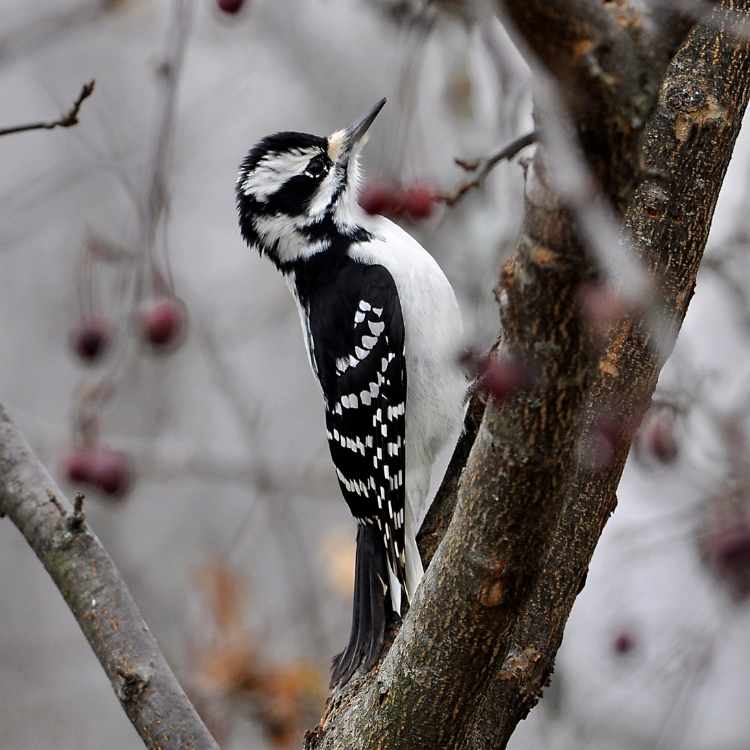
Interesting facts about Downy Woodpeckers
This species, like other woodpeckers, burrows into trees in looking for food or in order to establish a nesting place. Aside from that, they “beat,” or peck, in a quick rhythmic sequence in order to establish their area and attract mates. Drumming on resonant surfaces such as metal or wood is most common in the springtime. It may occur several times in a single day and linger for several days or even several months at a time.
Some other interesting facts about the Downy Woodpecker:
- The majority of the United States and Canada are home to this species, with the exception of the southwest deserts.
- Downy Woodpeckers are found in areas where trees thrive.
- Adult downy woodpeckers are the tiniest of all the woodpeckers found in North America.
Here you can check all Downy Woodpecker sounds
Interesting facts about Hairy Woodpeckers
When Hairy Woodpecker fights, it will elevate its wings at a 45 ° angle and lift its head skyward, all while producing shrill sounds from its mouth. Even during flying, this can occasionally be observed. Hairy Woodpeckers move in trees using a technique known as ‘hitching,’ which includes making small hops from branch to branch. The large, inflexible tail feathers of the Hairy Woodpecker aid the bird in its ascent up the bark of trees, providing additional stability.
Some additional amazing facts about the Hairy Woodpecker that you should be aware of are as follows:
- The hairy woodpecker’s nostrils are protected by a tuft of feathers that prevents grit and splinters created by pecking at wood out of his nose.
- In order to drill into trees and expel insects, a woodpecker’s beak has a long, thin form that is ideal for this task.
- Like all other woodpeckers, the Hairy Woodpecker has the ability to peck up to 20 times a second. It may produce between 10,000 and 12,000 pecks every day.
- Read more about the woodpecker in general in our post: woodpecker symbolism, the dead woodpecker symbolism or the woodpecker feather spiritual meaning.
Here you can check all Hairy Woodpecker sounds
Field Identification Tips
Downy Woodpecker
Examine the bill’s weight and length in relation to the head’s height. Downys have a beak that is significantly smaller than the breadth of the bird’s head. Take a look at the bird’s overall size. Downy is smaller in size than hairy, with a length of roughly 6.5 inches, which makes size a good field mark for distinguishing it from hairy.
Hairy Woodpecker
If you can see the underside of the outer tail feathers and they are totally white, you may be certain that you are dealing with a Hairy Woodpecker. Hairy is also slightly bigger than downy, with an average length of 9.5 inches.
Final Verdict
The downy and hairy woodpeckers are found in large numbers across North America. The most important characteristics for differentiating the two species in the field are their overall size and the size and form of their bills. Various plumage characteristics might be valuable when getting a good close-up picture of the bird. The tail feathers, for example, maybe utilized to differentiate between these two birds when recognizing them by their appearance. In contrast to hairy woodpeckers, whose outer tail feathers are frequently pure white, downy woodpeckers’ outer tail feathers are generally white with black barring, giving the illusion of being spotted rather than pure white.
Frequently Asked Questions
What is the easiest way to identify a Downy Woodpecker versus a Hairy Woodpecker?
The most reliable identification method is comparing bill size relative to head width. Downy woodpeckers have short, stubby beaks smaller than their head, while Hairy woodpeckers have longer, stronger bills nearly as long as their head. Size difference (6.5 inches vs. 9.5 inches) is another key field mark when visible.
Why do Downy and Hairy Woodpeckers look so similar to birdwatchers?
Both species share black-and-white plumage, white back stripes, and red crown patches on males, making them challenging to differentiate, especially for inexperienced observers. Their similarities in appearance and overlapping North American habitats frequently cause misidentification in the field.
How can you distinguish Downy and Hairy Woodpecker tail feathers?
Downy woodpeckers have white outer tail feathers with black barring or spotting, visible best from below. Hairy woodpeckers possess completely white, unmarked outer tail feathers, particularly in eastern U.S. populations. This plumage distinction is reliable when viewing the underside.
What do Downy Woodpeckers eat compared to Hairy Woodpeckers?
Downy woodpeckers favor suet feeders, millet, almonds, and nuts. Hairy woodpeckers primarily hunt insects like wood-boring beetle larvae, wasps, and moths, supplementing with berries, seeds, and nuts. This dietary difference reflects their distinct ecological niches and foraging behaviors.
Where do Downy and Hairy Woodpeckers live in North America?
Downy woodpeckers inhabit deciduous forests and suburban areas across most of the U.S. and Canada. Hairy woodpeckers prefer densely wooded regions with large trees, ranging from coastal to mountain forests in North America and Central America, avoiding suburban environments.
What are the lifespan differences between Downy and Hairy Woodpeckers?
Downy woodpeckers live approximately four years in the wild, while Hairy woodpeckers have significantly longer lifespans averaging twelve years. This substantial difference reflects their distinct ecological pressures and survival strategies in natural populations.
How do Downy and Hairy Woodpecker calls differ?
Downy woodpeckers produce whinnying calls lasting about two seconds with a high-pitched, declining sound. Hairy woodpeckers make sharper, more powerful peek sounds resembling squeaky chew toys, plus harsh rattles at single pitches, creating distinctly different auditory signatures for identification.
Do Downy and Hairy Woodpeckers migrate differently?
Downy woodpeckers are mostly permanent residents, though northernmost populations may migrate south in winter. Hairy woodpeckers remain non-migratory year-round throughout their range. This behavioral difference influences their regional presence and observation patterns seasonally.
What physical adaptations help Hairy Woodpeckers peck wood effectively?
Hairy woodpeckers possess stiff tail feathers providing climbing stability, a specialized long, thin beak for drilling, and nostril-covering feather tufts protecting against wood splinters. These adaptations enable them to peck up to twenty times per second, producing 10,000-12,000 pecks daily.
How many eggs do Downy and Hairy Woodpeckers typically lay?
Downy woodpeckers lay 3-8 eggs per clutch, while Hairy woodpeckers produce 3-6 eggs per clutch. This reproductive difference, combined with their distinct lifespans and migration patterns, demonstrates their different population dynamics and breeding strategies.
